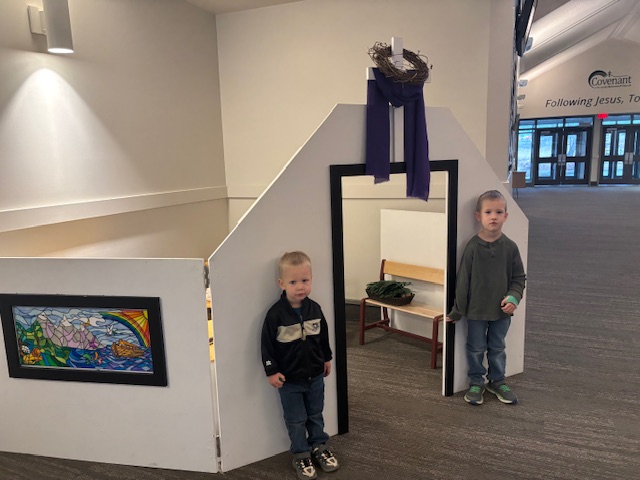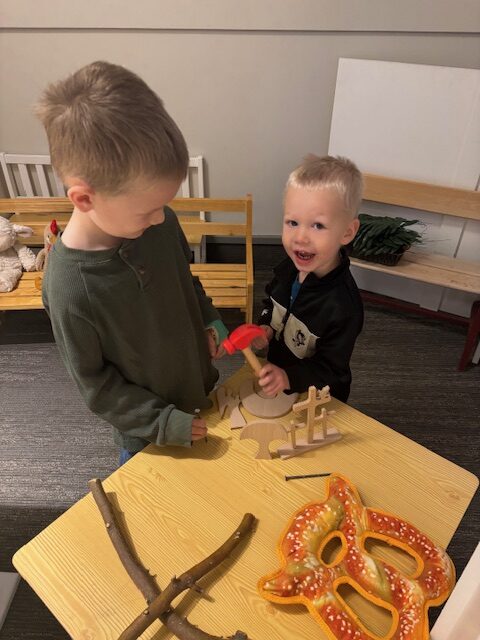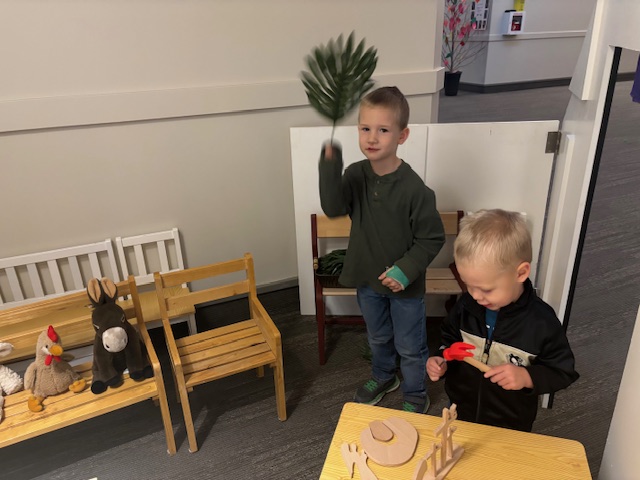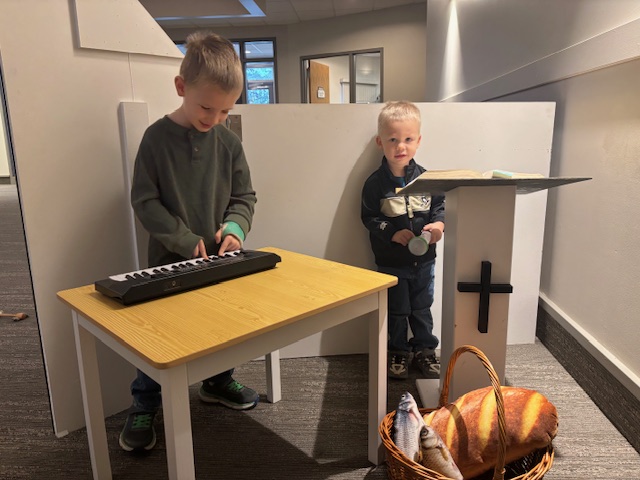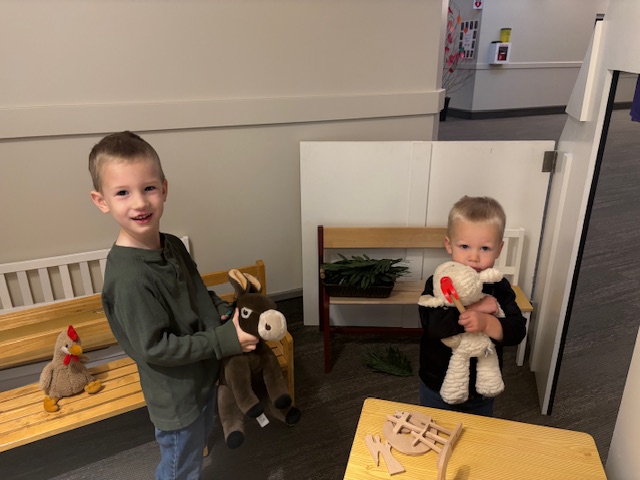Faith Formation is the lifelong process of growing a deeper relationship with God by integrating faith into all aspects of life. It goes beyond classroom education to include actions, experiences, and relationships and involves the whole person – mind, heart, and spirit. When we started brainstorming for a nursery renovation, the question for Covenant CRC became, “How can we integrate faith formation into a play-based environment?” This can also be described as sacred play. Many children imitate the actions, roles, and events they observe in adult daily lives in areas like careers, household chores, and recreational time.
Building a Play Church for Children
In a God-inspired moment, it became clear that we could use this concept for children to play church. Our team built a lovely little church based on playhouse models found in preschool and kindergarten classrooms, which included a pulpit, pews, stained glass windows, Bibles, and hymnbooks. The hope for Play Church was that it would lead to greater imagination, enhance children’s curiosity about the church they worship in, and allow them to grow in their knowledge of how and why we worship. We want children at Covenant CRC to feel encouraged to be involved and grow in their faith and relationship with Jesus. Kids are forming their faith by using their imaginations to play church, along with their learned experiences in the classroom and sanctuary.
How Much Do Kids Learn Through Play?
Have you ever noticed how much kids learn when they’re having fun? Playing has many developmental benefits, as noted in many school and childcare environments. These benefits can also extend to faith formation. Play-based learning utilizes children’s natural curiosity to create engaging learning experiences. These are hands-on experiences, so children are not just listening to their leader, but implementing what they have learned in an open-ended, play environment. Kids develop critical thinking skills by asking questions, observing, and testing ideas as they play. These are all essential life skills. It fosters social skills, which help develop children in Christ-like behaviours of communicating, sharing, collaborating, and empathizing.
Role play makes church positions less intimidating as kids learn how to serve in their home church. Play Church also develops children cognitively by removing barriers of fear and anxiety and instead helps kids feel welcomed and connected. Church can be associated with enjoyment through play and fun, stimulating independence and self-discovery. Children who learn about their identity in Christ can better overcome challenges, improve self-confidence, and set goals – essential life skills. All this type of learning and growing benefits children for the rest of their lives as they form a love for learning and a desire to explore and improve continuously.
The Problem with How We’ve Engaged Children in Church
Children have been relegated to the back of the church for too long. They are sent off to segregated classrooms with the expectation of “be quiet and listen” behaviour, until they are told to perform seasonal songs and skits for congregants to ooh and ah over. This is not a helpful process for faith formation. Children need to be engaged; they need to be able to ask questions, make noise, and feel like valued members of the church. We can see the statistical proof as church memberships continue to decrease across North America. Kids of all ages are disengaged and asking, “How is this relevant to me? Why should I care?”
The Four Building Blocks of Faith Formation
Laura Keeley and Robert J. Keeley formulated four building blocks of faith formation, which the Christian Reformed Church has used for many years:
- I Belong,
- I Know & Understand,
- I Have Hope,
- I Am Called & Equipped.
“For our faith to grow, our deep need for belonging must be met. We need God’s Spirit and God’s people to help us know that we belong to God and that we belong in God’s family, the church.”1 This is true for people of all ages. Covenant’s Play Church is set prominently in our church foyer so that children and adults alike instantly see that our small members matter. In this visible area, the message is clear that children are important and treasured members of our church family.
Janine Taylor, one of our parents, commented, “I think one beautiful aspect is this has been a place for play and a place for kids to find refuge when they need a quiet corner to sit in, a space they feel comfortable in”.
Citation
1. https://www.crcna.org/FaithFormation/toolkits/building-blocks-faith/what-are-building-blocks-faith
Play Church Through the Liturgical Calendar
Throughout the church season, dramatic play elements are incorporated to help children make meaning. For example, when people are baptized in our church, a baptismal font and a baby doll are added. During the baptism, all children are invited to the front of the sanctuary to participate in a discussion and sharing of the sacrament. Then they can practice this knowledge themselves in Play Church.
In the sanctuary, the cloth on the cross changes colours as per the church season. So we follow suit with Play Church:
- ordinary or teaching time (green),
- preparation (purple),
- celebration (white),
- Pentecost (red).
As well as the play elements inside the church:
- wooden Advent candles with detachable flames,
- fish and bread,
- names of God,
- flame-coloured wands,
- symbols of Lent, etc.
Leaders will often teach kids a concept or biblical narrative, and then they will find items that connect within Play Church. During Lent, I taught all CovKids about various symbols of Lent and what made them significant. Therefore, they found:
- a stuffed donkey,
- a rooster,
- a lamb,
- a crown of thorns,
- palm leaves,
- hammer and nails,
- a pretzel,
- water,
- a cross,
- a money bag with coins.
With the shared learning experience in the classroom, children can use common liturgical language and remember theological concepts regarding Lent and Easter as they play. They also provide mutual support for each other as they process their worship experience through re-enactment and using the knowledge they have acquired. When I overhear phrases like, “when the rooster crowed”… and “the pretzel is shaped like we pray”… or shouting “Hosanna!” and waving palm branches, I know they are actively involved in their own reflection of faith and connecting it to themselves.
Children Teaching Us About Faith Through Play
The whole purpose of Play Church was for children to make meaning from their worship experience through play, much like they do with their homes when they play house, and careers when they play hospital or carpenter. I didn’t really expect that Play Church would become such a useful teaching tool. It’s an opportunity for children to take their knowledge and use it in a playful way, thus processing their own faith formation. After a service where communion was served, I overheard children serving bread and wine to one another, repeating the pastor’s words of “Take, eat, remember and believe”.
While the play elements have been intentionally placed there, it is not directed learning. Children are invited to use these tools as unprompted replications of what happens in a church sanctuary within the tiny walls of Play Church.
I also love how it honours learning styles (how people best absorb and process information), such as physical, visual, and social, that might not be found elsewhere in a worship situation. Children are observed preaching, singing in choirs, reading Scripture, and baptizing babies. They also express wonder and excitement when new items arrive, which they can experiment with. Questions often come up pertaining to cloth colours, the words printed on Advent candles, and other items children might not be familiar with. It’s astounding to me how much young children are learning about their church! Perhaps this is an area for ministry leaders to examine how other age groups could benefit from using their imaginations as a pathway to faith formation.
Conclusion: The Power of Sacred Play
Play Church has exceeded my expectations regarding early childhood faith formation. As I have observed children play, they have taught me how important their imaginations are in processing worship experiences, practicing belonging, and developing spiritual understanding. Children will take this experience forward as they continue their lifelong faith formation journey. What better way to honour God and how he has created us by utilizing a child’s natural disposition for curiosity and imagination to develop a deep relationship with Him?
-
Citation
1. https://www.crcna.org/FaithFormation/toolkits/building-blocks-faith/what-are-building-blocks-faith
